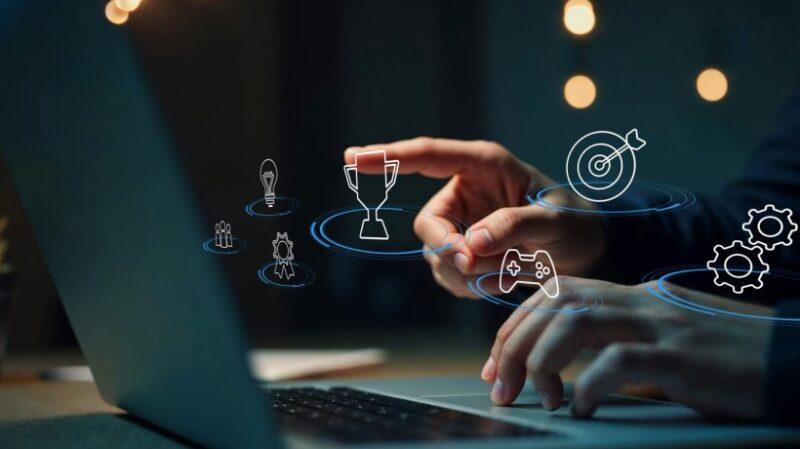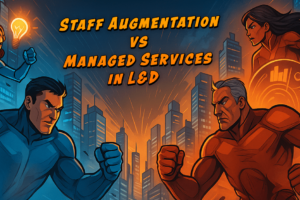
Implement Gamified Learning: Transforming Employee Training

Implement Gamified Learning
Traditional corporate training is usually quite a drag. Typically, long slides, mandatory modules, and standard courses result in employee disengagement as they navigate through them. On the other hand, by gamifying the learning process, boring employee training can be converted into an engaging and interactive experience. A gamified employee training program featuring game-like elements such as points, levels, badges, and challenges does not merely alter the atmosphere of a training session but also invigorates participants, encouraging them to approach it more like a game and less like work. In this article, we will delve into the reasons behind gamified learning lasting longer than just a fad, the way it affects business outcomes, and some practical strategies for successful implementation.
Why Traditional Training Often Falls Short
Even the most perfectly designed learning programs may fail to produce the expected results. Some common issues the organizations face include:
- Low motivation
Employees perceive a training program as a mere formality completed just to satisfy management, rather than as a real way to acquire new skills. - Generic content
Standardized modules do not account for individual learning styles or speeds. - Delayed feedback
When the feedback is not immediate, newly learned knowledge is quickly forgotten. - Weak link to business outcomes
If learners fail to see a clear connection between training content and their work, their commitment weakens.
Why Gamified Learning Matters
The following are some of the benefits of gamified learning:
- Higher engagement and motivation
Gamified training consistently delivers higher engagement compared to traditional learning. Surveys show that most employees feel more motivated when participating in gamified training compared to traditional programs, where motivation tends to lag. - Better knowledge retention and performance
Just-in-time feedback, leveling effects, and challenges help employees retain knowledge for longer periods. - Direct business impact
Social gamified learning links employee perspectives with business outcomes that can be measured such as sales, compliance, customer satisfaction, and innovation culture. They are not merely numbers; they signify that gamified learning is a strategic weapon, not only a source of engagement.
How To Implement Gamified Learning Successfully
Here’s the road map L&D teams must follow to make gamified learning work.
1. Align With Business Goals
Start by defining what success looks like. Be it higher sales, safer workplaces, or better customer service, make sure gamification elements you choose directly support these outcomes.
2. Layer In Game Mechanics
Introduce a progression system, where the participants gain experience points and levels. Moreover, challenges in the form of scenario-based quests can be introduced. Badges and rewards can be offered for completing activities and achieving objectives.
Additionally, leaderboards can provide a friendly way to compete. Offer performance feedback in real time. Leverage storytelling to help them comprehend the background and significance of the training material. Balance extrinsic rewards with intrinsic motivators.
3. Include Realistic Simulations
Give employees the chance to go through various work scenarios that could be risky in real life but pose no actual harm, such as handling a difficult customer, reacting to a safety incident, or making an important business decision. Mordor Intelligence, in its report, says that the worldwide gamification market will hit $92.51 billion by the year 2030, highlighting how the use of gamification is becoming more and more important in business strategic planning [1].
4. Personalize The Experience
Give learners the freedom to choose their own learning path, overcome challenges at their own speed, and receive helpful feedback. Customized learning experiences help sustain learner motivation and engagement.
5. Connect Gamification To Culture
Celebrate achievements through internal recognition, leaderboards, or badges visible to peers and managers. Active leadership involvement amplifies results.
6. Measure And Iterate
Measure engagement, learning, change of behavior, and business outcomes. Collect data to adjust the gamification aspects and maintain the learning journey, fresh and engaging.
Looking Ahead: Future Trends To Implement Gamified Learning
According to a report by Open Loyalty, gamification leads 2025 loyalty investment priorities, with 45% of loyalty professionals identifying it as the most influential trend for the next 2–3 years–surpassing automation (40%) and partner-based marketing (33%). The upcoming trends in gamified learning are very promising, including:
- Extended Reality (XR) + gamification
Training in immersive AR/VR environments. - AI-driven adaptive learning
Real-time personalization based on performance and behavior. - Social and collaborative gamification
Team-based quests, peer challenges, and knowledge sharing. - Continuous learning
Game elements embedded into daily work, not just formal training. - Cross-platform digital credentials
Gamified achievements that employees can display internally and externally.
Conclusion
Gamified learning transforms the training process from a boring experience into an engaging, motivating, and goal-driven journey. Are you ready to improve employee training’s efficacy and engagement? Get in touch with us to improve your training programs with gamified learning and drive meaningful business impact.
Reference:
[1] Gamification Market Analysiswww.infoprolearning.com
Source link



